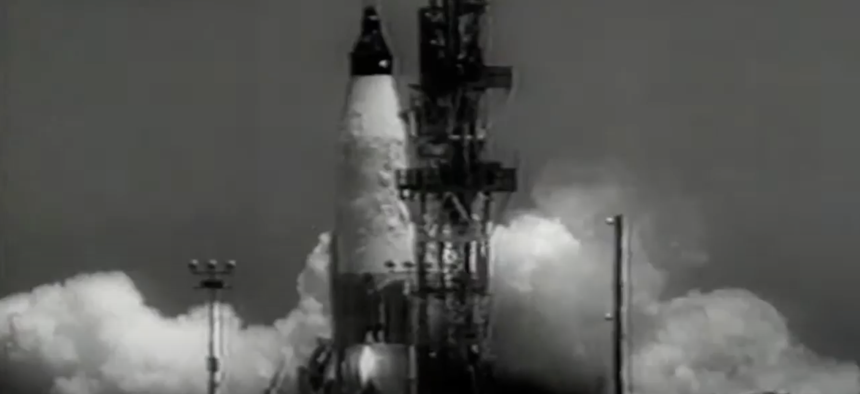
NASA's MA-3 rocket lifting off in April 1961. NASA
That Time NASA Blew Up a Rocket and People Called it a Success (No, They Didn’t)
The “failure is not an option” standard demanded of the space agency has long hampered its efforts.
The latest in an intermittent series looking back at groundbreaking, newsmaking, appalling and amusing events in government history.
On April 25, 1961, NASA launched Mercury-Atlas 3, one in a series of tests of the rocket that would carry the first American into space. Inside the capsule at the top of the rocket sat a “robot astronaut,” an electronic mannequin that could inhale and exhale gas, heat and water vapor, simulating in key ways what an astronaut would experience.
At 11:15 a.m ET, the spacecraft lifted off, engines blasting. Straight up, and up and up, it went.
In MA-3, as the mission was known, the rocket was supposed to roll and pitch, then head out over the horizon. Instead, it was just going higher and higher, and if it came straight back down into the launch area, the outcome could be deadly. So, 43 seconds into the mission, the range safety officer pulled the plug, giving the order to blow up the rocket.
That wasn’t the outcome NASA had hoped for, but it had a silver lining. The spacecraft’s emergency systems kicked into gear, separating the robot-carrying capsule from the rocket booster, deploying its parachute and depositing it gently in the Atlantic Ocean a few miles away. The capsule suffered so little damage it was reused in the next test launch.
“This was the very first Mercury test with a live escape tower and it worked flawlessly,” reads one account of the day’s events written decades later. By any reasonable standard of space exploration—especially in those wild early days, when NASA was desperately trying to catch up to the Soviet Union—the launch was at least a partial success. But you wouldn’t know that from the reaction to the day’s events.
“Man-in-Space Project Snags as Atlas Fails,” read the headline on an Associated Press story on the launch. “The spectacular failure certainly will deal a blow to United States scientific prestige,” AP reported.
“There is no excuse for failures of this kind in a vehicle as well-developed as the Atlas,” said Rep. George Miller, D-Calif.
Even the exemplary execution of the capsule separation process was viewed as a negative. “In the light of recent Soviet space successes, nothing could be more ignominious…than to have the first manned space flight end—however safely for the astronaut—on the beach at Cape Canaveral a minute after lift-off,” wrote William Hines in The Washington Star.
Sixty-two years after the MA-3 launch, at 9:30 a.m. ET on April 20, 2023, a massive SpaceX Starship rocket blasted into the sky from the company’s launch facility in Boca Chica, Texas. About four minutes later, several of its engines failed, it spun out of control, and company officials gave the order to destroy it.
The reaction in the news coverage and among the public was very different than after the MA-3 failure (or virtually any of NASA’s other launch failures). “Why SpaceX’s Starship Explosion is a Low-Key Success,” read the headline on the day’s events in The Washington Post. “Why SpaceX’s Starship Explosion Is No Big Deal,” reported Time.
"The whole job of the test is to find out what goes wrong, to let things fail," said Chris Hadfield, former commander of the International Space Station. "They were so successful today.”
SpaceX employees, who burst into cheers and applause as Starship exploded, even found wry humor in the day’s events. “As if the flight test was not exciting enough, Starship experienced a rapid unscheduled disassembly before stage separation,” the company tweeted.
It’s far from the first time a SpaceX rocket has exploded. And it’s not as if Elon Musk is just risking his own money blowing up rockets. SpaceX has a contract worth nearly $3 billion from NASA for use of Starship in ferrying astronauts to the moon. But private companies, especially those run by high-profile, self-promoting entrepreneurs like Musk, are held to a different standard than government agencies.
For NASA, the die was cast years before the MA-3 launch, when the agency was testing Vanguard rockets for potential space flights. In December 1957, one of them spectacularly exploded on the launch pad. This and other early launch misfires “made the entire program a symbol for failure in the public mind,” according to an official NASA history. “The lesson of Vanguard was plain. NASA could not afford to regard failure as acceptable under any guise. Success had to be sought on the first try, and every reasonable effort bent toward achieving that outcome.”
Given that the currently trendy doctrine of failing fast has never been applied at NASA, it’s a wonder the agency managed to land astronauts on the moon, fly space shuttle missions, play a leading role in the construction and operation of a space station, deploy an incredibly powerful space telescope and send multiple rovers to Mars, among many other accomplishments.







